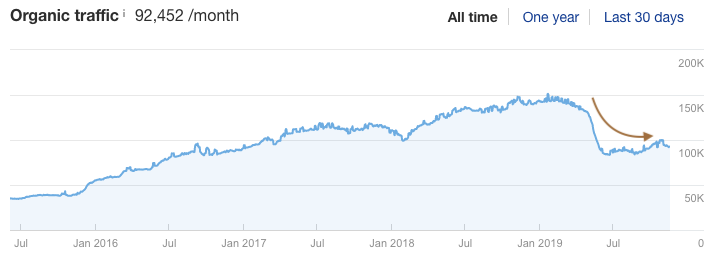As SEO professionals, we are no strangers to migrations and the various levels of volatility they can bring.
Migrations are naturally occurring events in the life cycle of digital businesses as both technology and business objectives advance.
A migration, despite its impact on SEO, can enhance visitor experience if done correctly.
Upgrading to a faster host may increase your ranking performance over time (by influencing and providing better user signals).
Although initial re-indexing by Google may cause a temporary decline in organic traffic, a well-executed migration plan can maintain or even improve your SERP standings.
Defining The Migration Type
A website migration involves a substantial change to a website’s technology, structure, design, or location to enhance online visibility.
Each type of migration carries a certain level of risk, and when you begin to stack different migration types (and change more variables), the risks don’t stack, they begin to amplify.
As SEO professionals, some of the more common migrations we’re used to being involved with include:
- Restructuring URLs.
- Changing protocol (HTTP to HTTPS).
- Changing hosting providers.
- Moving to a new platform.
- Changing domain names.
- Merging multiple domain properties together.
In the industry, we hear about migrations going wrong, namely when they start to impact the world outside of SEO.
Losing some traffic and a few rankings isn’t headline news, but businesses closing down stores and laying off staff is.
Examples of this include the Homebase HTTPS migration (as covered in-depth by Omi Sido here) and the more recent Logojoy to Looka rebrand, which, when looking through the eyes of third-party tools, shows a decrease in ranking keywords of 25,000 (150k to 125k).
Scoping An SEO Migration
For me, getting the scoping of a migration correct is essential to the success of the migration process as a whole, and important in avoiding situations like this:
-
 Example of a site migration where SEO consultancy was brought in too late, and after all key decisions had been made.
Example of a site migration where SEO consultancy was brought in too late, and after all key decisions had been made.
A key part of the scoping and specifications is that it needs to be actionable for both developers and wider stakeholders:
- Reducing the “why.”
- And focusing more on the “how.”
Ambiguity creates risk. The less room for misinterpretation, the better.
Within the scoping document, it’s essential to establish:
- The reasons for the migration taking place (from the client).
- Primary and secondary stakeholders.
- The scope of activities and responsibilities from each stakeholder (maintaining traffic and rankings is not a responsibility, it’s an objective).
- The timeline for activities, plus post-migration resources.
- Agreed-upon (by all parties) objectives of the migration.
- Reporting frequency and depth.
From this, you can begin to create a schedule of activities to reduce as much risk as possible.
SEO Migration Risk Mitigation
For the most part, risk mitigation during any migration is carrying out what is, for many, general migration activities.
Each activity, however, is designed to reduce elements of risk and work toward achieving the agreed-upon objectives.
Redirects
It’s a given that redirects are part of almost all migrations.
However, having performed a number of post-migration traffic drop audits, here are some common errors made when scoping and implementing redirects.
Redirects serve as navigational guides for both browsers and search engines, providing information about a webpage’s location based on a given URL.
They represent coded instructions assigned to specific URLs, or a set of them, rerouting the user or search engine from the original input or clicked URL to a different page.
For migrations where URLs change, Google has stated it can take up to 180 days for the value to fully pass from A to B.
Depending on your migration, the scope of your redirects will change.
JS, CSS, Parameters & Media Files Not Redirected
More often than not, when migration is carried out, people focus on redirecting the URLs – as those are what rank – but you should also be looking at redirecting your JS files, CSS, Parameter URLs, and media files (images, videos) if necessary.
A lot of people question the value of redirecting images, but a URL is a URL, and Google will have crawled it. Google has even recommended that you should redirect image URLs.
Environment Changes
When migrating to a new platform, redesigning templates, or updating the site structure, it’s important to ensure that the new “environment” mirrors the SEO qualities of the previous, at a minimum.
Oftentimes the new platform goes live, and a lot of content is hidden behind JavaScript expandable areas, and with NoScript or JS disabled, it remains hidden – or other key elements have been missed.
So, it’s important to audit the new environment to check that:
- Metadata has been carried over correctly.
- Structured data has been implemented and is validated.
- Canonicals are correct.
- Pagination mark-up is correct (Bing exists, too!).
- Internal linking has been carried over and points to 200 URLs.
- XML and HTML sitemaps are present.
- Hreflang is set up correctly (if you’re an international website).
- Redirects have been tested.
- Your 404 page returns a 404 response code.
Some things, like site speed, will require live site testing unless the staging and pre-production environments are on mirrored stacks (so you can emulate the same performance). But more often than not, they’re not on performance-orientated servers.
Understanding Why Migrations Go Wrong
Oftentimes when a migration goes wrong, it can be pinpointed to at least one of seven reasons, these being:
- Incorrect SEO strategy or unclear objectives.
- Poor planning and scoping of resources and timeline.
- Unforeseen UX or design changes that impact content or code.
- Involving the SEO agency too late or after key decisions have already been set in stone.
- Poor or lack of sufficient testing.
- Slow responses and low development priority to post-migration bug fixes.
- Uncontrollable variables (e.g., Google update).
Poor Strategy
Understanding why the migration is taking place and the desired outcomes is critical in order to set measurable benchmarks for “success.”
For most migrations, the objective is to maintain SEO performance and then use said stability as a foundation for growth.
However, each migration type has its own set of risks. These need to be communicated to the client and wider stakeholders.
If you’re moving hosting or platform but maintaining URL structures, it should be seamless, but if you’re rebranding and changing the domain name, expect some period of turbulence.
It’s also important to note that poor strategy can also come from the business.
Sometimes stakeholders create plans on how the website, brand, and wider strategy will move forward, but the business strategy (and expectations) don’t marry up with the proposed timelines or what is technically feasible.
Poor Planning & Scoping
Devising a detailed scope and project plan early on can help avoid delays along the way by setting expectations of how long SEO processes and tasks take.
This also allows you to factor in what is and isn’t within the scope of the project, so you can schedule and allocate resources adequately.
By setting out a plan, you can also identify potential obstacles, such as public holidays or peak sales periods.
For example, as an online retailer, you wouldn’t launch a website in the days running up to Thanksgiving, as major bugs could jeopardize your Black Friday/Cyber Week/Christmas period.
Late Involvement
SEO migrations don’t happen overnight.
However, SEO support is oftentimes sought too late down the roadmap, with many critical decisions made beforehand that will impact organic search performance.
Sometimes the late involvement can be a saving grace, as long as there is room in the timeline for changes to be made – but that is seldom the case, and you can only watch and prepare for the post-mortem.
This can also mean that there is a lack of sufficient testing (from an SEO perspective), and not all performance-affecting issues may be resolved in time if the migration deadline is rigid.
Slow Development Response Times
This is, more often than not, an issue with the business itself and not something SEO professionals can control.
I’ve been in situations before where immediately after the migration, the development resource has been fully rededicated to another part of the business, leaving no time for urgent or ad hoc bug fixes.
More often than not, this isn’t the developer’s fault but more a symptom of poor planning from decision-making stakeholders.
I’ve seen websites go live before with a sitewide noindex (as the wrong bucket had been deployed), something we flagged almost immediately – only for it to take four days for the resource to be allocated to remove it.
Uncontrollable Variables
Every now and again, despite the best planning and resource allocation, you’ll get sideswiped by something unforeseen and completely unavoidable – such as a Google update or the CDN/DNS suffering outage.
A good example of this came in August 2020, when Caffeine broke. During this time, new URLs weren’t being indexed.
Ineffective Communications With Stakeholders
When speaking to companies about their migrations, and migration strategies, one of the key issues is around the communication and expectation level of indirect stakeholders, typically VPs and C-Suite.
It’s important that all risks are outlined both in the technical terms of the delivery but also summarized and digestible for the non-technical C-suite.
In these summary documents, it’s important to not only outline the risks but also what we expect to see – as the experienced consultants we are – and at which points we need to start triaging/panicking.
This greatly reduces the pressure from kneejerk reactions and scrambling due to C-level involvement and not understanding the whole picture.
More resources:
- Google Shares Advice on Site Migrations
- How To Migrate A WordPress Site From One Host To Another
- The Ultimate SEO Audit Checklist
Featured Image: 123graphic/Shutterstock





